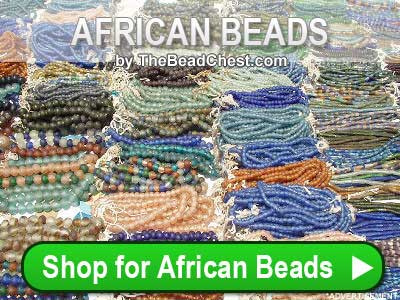Tribal jewelry can be difficult to emulate with ‘Western’ beads. Somehow, they just don’t have that same primitive beauty and rusticity you get from beads that have been made by hand. Admittedly, I’ve often overlooked African wood beads in favor of stone and clay varieties, simply because I’ve never appreciated their aesthetic value. But, after a little experimentation, I’ve been inspired. Cheap, lightweight and strikingly beautiful, here are three varieties of African wood beads you can pick up for under ten dollars.
Rosewood Beads
African Rosewood is a beautiful timber characterized by its deep reddish-brown color and dark veining. Being a relatively hard wood, it’s both heavy and durable, making it a popular choice for prayer rosaries and healing bracelets. Genuine African Rosewood has a strong, slightly sweet smell said to relieve nervous tension and migraines. The warm hues of dark rosewood beads work particularly well with brass and copper beads from Ghana.
Kenya Palm Wood Beads
As the name might suggest, Kenya Palm Wood looks markedly similar to the wood of the coconut palm – a light base flecked with darker stripes of color. Kenya Palm Wood Beads are typically darker than most other types of palm wood; the darker hue being more akin to mahogany. Traditionally these beads are often strung with raw Tagua nuts, which are now a common substitute to animal ivory among many tribes.
Olive Wood Beads
With their beautiful dark rings and fine grain, Olive Wood Beads are the perfect focal bead for bohemian jewelry projects. These exquisite wooden beads – which look a little like walnuts – hail from the holy town of Bethlehem, where artisans have been producing them for centuries for Christian rosaries. Olive wood is a hardy, honey-blond wood with a fine grain and smooth finish, making the beads particularly ideal for necklaces and earrings. Olive wood beads are a beautiful accent to recycled glass beads in muted colors, such as sea green and pale blue.

 African beads, trade beads, and antique beads have been enjoyed by many for centuries. African beads are treasured for their history. Many have traveled over 3 continents and can be up to centuries old. This blog is devoted to providing you with accurate information on African beads, trade beads, and antique beads. We hope you enjoy our blog!
African beads, trade beads, and antique beads have been enjoyed by many for centuries. African beads are treasured for their history. Many have traveled over 3 continents and can be up to centuries old. This blog is devoted to providing you with accurate information on African beads, trade beads, and antique beads. We hope you enjoy our blog!